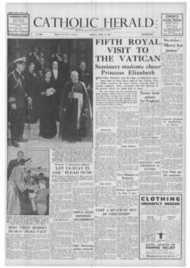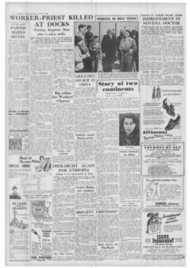Page 6, 20th April 1951
Page 6

Report an error
Noticed an error on this page?If you've noticed an error in this article please click here to report it.
Tags
Share
Related articles
No Escape For
Mauriac's First Novel
Outstanding Fiction By Catholics
Another Maur:ac
Perpetual Midnight For Ma Uria C
MAURIAC and WAUGH
That Which Was Lost and Tha Dark Angels by Francois Mauriac. (Eyre and Spottiswoode. 10s. 6d.) Reviewed by W. J. IGOE CE Qui Daft Perdu, now trans
lated by Capt. J. H. F. McEwan, was published in 1930 when, in this country, Mr. Evelyn Waugh was writing his first successful books. It may be interesting to note the similarity of the characters created in the context of characteristically different treatments, by these Catholic artists.
Each in his way dealt with -bright young people" shocked, stunned by the impact of modern war into becoming sensory automata. One recalls the "lovers" of Vile Bodies and A Handful of Dust impotent to love, sadly experimenting in lust and "not liking it"; the absurdity of a loveless world that later Sartre would irri-tate with lachrymosity into a philosophy, then was seen in truer perspective by Mr. Waugh
A decade of years before the second world war, his satire, plus the animal violence of Mr. Hemingway, said all the needful on the subject of human existence in a spiritual vacuum.
The characters of M. Mauriac, in themselves, are more sharply focused than those of Mr. Waugh.
The Englishman's vision included a community, the cities of the period, at least the fashionable parts of those cities. Mauriac assembles a cast as for a play; it is significant that when an "extra" is required, ThereAe Desqueyroux, leading lady, as it were in his most impressive work, is brought from the shadows momentarily to walk across-stage. Mr. Waugh's characters inhabit # recognisable world of their own; NI. Mauriac's seem to move against the background of a cloud-swept sky, in a lowering atmosphere, and are haunted by a God whose very Christianity is ambivalent; He threatens ever.
THERE is no plot to the first of these books; the characters exist in close-up, so that the glimpses we get of other life are seen merely, so to say, over their shoulders. All, like Mr. Waugh's creations mentioned, are isolated from each.
The themes are provided by an atheist dying of disease. her hideous hedonist of a husband and his devout and conscience-stricken mother, a middle-aged husband. his unsatisfied young wife and her brother, a convert and aspirant to the priesthood. They appear, one dies, another makes her confession, all are selftortured; two love God.
The chapter dealing with the deathbed is among the most powerful written by M. Mauriac and makes an interesting comparison to the similar scene in Madame Bovarv; the description of a confessional touches a peak of poignance, relieved by a beautifully dramatic revelation of character. showing the writer at his wonderful best.
Les Anges Noir pursues Alain Foreae, the boy of the first book, as a priest, contrasting him with, perhaps. the character he, but for the grace of God. might have been, an evil ex-seminarist who. enmeshed in sin. conflicts with God through the priest.
It is worked out with an inevitability that. on first reading appears engineered. the final effect being too neat—that is for M. Mauriac.
The new Penguin reference book, A Dictionary of Biology (2s.) is an extremely useful addition to the reference shelf of the non-biologist. Science News 19 is as good as the other 18, and that says much-particularly interesting for the nonscientist is the article on " Guidance Devices for the Blind " and a review of the past 50 years in physics.
blog comments powered by Disqus









